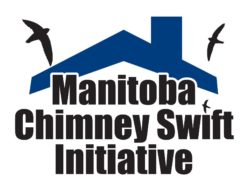AUGUST 24: Going, Going…have your Chimney Swifts gone?

Today’s blog offers a friendly reminder to head out to the chimney sides tonight, a quick summary of recent trends at nest and roost sites, and several info bits on interesting bird research and reconnaissance.
Today is a Wednesday MCSI Swift Watch Day and you may note a big change at your roost or nest site. Maybe you will see no Chimney Swifts. Sigh. Remember, those valid zero counts – the zip, Nada, nothing to see here folks’ moments – are as important to harvest at the end of the season as they are at the beginning. Departure and arrival dates are all based on seeing no swifts.
Our Manitoba Chimney Swifts are in transition. Most nest sites are now unused during the day after fledglings burst out. However, a few late starting breeders are still feeding non-brooded young (e.g., the Men’s House at Lower Fort Garry where fledging is being tracked by Gerald and Jo). Some roost sites have dramatically dwindled in numbers (e.g., first noted by the Dauphin monitoring crew of Ken, Jan, Pat & Marilyn). I am chasing the St Adolphe flock to find a pre-migratory roost. Many other people in many other locations are continuing the swift quest missions. Thanks for all your efforts!
There is much to do to wrap up the season and it’s not always fun monitoring. Seeing nothing at the season’s end is bittersweet. You don’t want the birds to be caught short if bugs disappear before the last fledglings emerge and after other Chimney Swifts move further south. BUT there is always the pleasure of seeing a swift just one more time…
Moving along to birdy news from afar, there have been interesting issues reported in the media:
Sound experiments capture ‘pernicious’ impact of noise pollution on wildlife https://www.cbc.ca/news/science/what-on-earth-noise-pollution-1.6555253
Even our urban adapted Chimney Swifts have tolerance limits to noise. We have found that the birds are sensitive to loud, random “jackhammering” noises and will avoid using their nest sites during times of noisy nearby construction.
So many birds are in the sky at Ontario’s Long Point right now, they’re showing up on radar https://www.cbc.ca/news/canada/london/roost-ring-long-point-birds-1.6558586
Our Manitoba Chimney Swifts are on the move but not in the numbers that would create “roost rings” (in our dreams!).
Tim has flown over some intriguing information about tracking movements of tagged Chimney Swifts:
MOTUS is an automated radio telemetry tech now being established across North America and established by Birds Canada. Put simply, a network of receiving towers has been set up across the continent (including about 14 in MB) and these receive signals from a radio transmitter deployed on a bird which records the approximate location (usually within 20-30 km of the tower). It does not give fine-scale habitat info but it does tell us where birds migrate. More info at https://motus.org/about/
A receiving tower was recently established at the Ellice-Archie Community Pasture in early July – the feds are monitoring Bank Swallows and grassland SAR. It turns out that a CHSW tag was pinged at the MOTUS Tower on Ellice-Archie on July 24th. I guess there’s always a chance there’s a tech mishap but the following is potentially fascinating. The tag was deployed on a swift in Beloeil, QC, near Montreal, on May 19th. The last detection in QC was at another receiver near Montreal on June 11th. The bird was not detected again until it turned up in western MB on July 24th! It was only pinged once here and then it disappeared again before being detected at a tower south of Tampa on August 11th. This is all publicly available info so thought you would all be interested in hearing about the amazing swift journey.
The details of bird detections are at https://motus.org/data/tagDeploymentDetections?id=38341.
Check out the project page for MOTUS tracking of Chimney Swifts: https://motus.org/data/project?id=195
The general description of the data can be found at: https://motus.org/wp-content/uploads/2016/01/MotusCollaborationPolicy.January2016.pdf .
That’s a wrap for this week. Send your monitoring reports along as we track the final phase of the 2022 season! Things will likely wrap up at most sites by August 31-September 7 (unless our keen-eyed Selkirk Birders spy swifts later in the season again this year).
- Happy Swifting, Barb.

Just wondering where you would like “hard copy” data sheets sent seeing that there still isn’t a coordinator for Nature Manitoba?